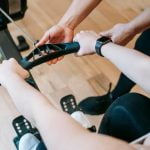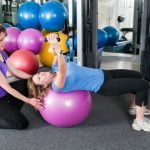Are you looking for ways on how to keep your body fit with exercise? Physical fitness is a key component of overall health and well-being, and exercise plays a crucial role in achieving and maintaining it.
From setting realistic fitness goals to creating a personalized exercise plan, there are numerous strategies to incorporate regular physical activity into your lifestyle. In this article, we will explore the importance of exercise for physical fitness and provide valuable tips on how to start, stay motivated, and overcome common barriers on the journey to a fitter body.
Regular exercise not only helps in keeping your body fit but also offers a wide range of benefits, including improved cardiovascular health, increased strength and endurance, better flexibility, and enhanced mental well-being. This introductory section will delve into the significance of incorporating exercise into your daily routine and its positive impact on overall physical fitness. By understanding the value of exercise, you can develop a deeper appreciation for its role in maintaining a healthy body.
As we embark on this exploration of how to keep your body fit with exercise, we will address the importance of setting realistic fitness goals, types of exercises for a full-body workout including cardio, strength training, and flexibility workouts. Additionally, we will discuss creating an individualized exercise plan that works for you while considering various barriers such as time constraints, lack of equipment, or physical limitations.
It’s time to prioritize your physical fitness and discover the lifelong benefits that come with regular exercise.
Setting Realistic Fitness Goals
Getting Started
When embarking on a fitness journey, it’s important to set realistic goals that are achievable and sustainable. Whether your goal is to lose weight, build muscle, or simply improve your overall health, starting with small, attainable milestones can help you stay motivated as you progress towards your larger objectives.
It’s also essential to be patient with yourself and understand that results take time. Celebrate the small victories along the way and use them as fuel to keep pushing forward.
Finding Motivation
Staying motivated is often one of the biggest challenges when it comes to maintaining a regular exercise routine. One effective way to stay motivated is by finding an exercise program that you enjoy. Whether it’s dancing, hiking, swimming, or weight lifting, finding activities that you genuinely look forward to can make it easier to stick with your fitness regimen. Additionally, consider enlisting the support of a workout buddy or joining a fitness community for accountability and encouragement.
Maintaining Consistency
Consistency is key when it comes to achieving fitness goals. To stay on track, consider establishing a regular workout schedule and treating exercise as an important appointment that cannot be missed. Set reminders on your phone or calendar, create a dedicated workout space in your home, and prioritize your fitness just like any other important commitment in your life. Remember that consistency is what will ultimately lead to long-term success in reaching and maintaining your fitness goals.
Types of Exercises for a Full Body Workout
When it comes to keeping your body fit with exercise, it’s important to incorporate a variety of workout types to target different aspects of physical fitness. The three main types of exercises that make up a full body workout are cardio, strength training, and flexibility exercises. Each type of exercise offers unique benefits that contribute to overall physical health and well-being.
Cardiovascular Exercise
Cardio, short for cardiovascular exercise, is any type of activity that gets your heart rate up and increases blood circulation. This type of exercise is crucial for improving cardiovascular health, endurance, and burning calories. Some common forms of cardio include running, cycling, swimming, and brisk walking. Aim for at least 150 minutes of moderate-intensity cardio per week or 75 minutes of vigorous-intensity cardio spread throughout the week.
Strength Training
Strength training focuses on building and toning muscle mass through resistance exercises. This type of exercise not only increases muscle strength but also helps improve bone density and metabolism. Strength training can be done using free weights, weight machines, resistance bands, or even just your own body weight. It’s recommended to include strength training workouts at least two days per week targeting all major muscle groups.
Flexibility Exercises
Flexibility exercises are essential for maintaining a full range of motion in the joints and preventing injuries. Stretching, yoga, tai chi, and Pilates are great examples of flexibility exercises that can help improve posture, balance, and overall mobility. Aim to incorporate flexibility exercises into your routine at least two or three days per week for optimal results.
By incorporating all three types of exercises into your workout routine – cardio, strength training, and flexibility – you can achieve a well-rounded full body workout that promotes overall physical fitness and supports a healthy lifestyle.
Creating a Personalized Exercise Plan
- Assess Your Fitness Goals: Determine whether you want to lose weight, build muscle, improve flexibility, or simply maintain overall fitness. Setting specific and realistic fitness goals will help you tailor your exercise plan to meet your individual needs.
- Choose Activities You Enjoy: Incorporating activities that you enjoy into your workout routine can make exercising more enjoyable and sustainable. Whether it’s dancing, hiking, swimming, or playing sports, find activities that you look forward to doing.
- Mix Up Your Workouts: Variety is key to preventing boredom and avoiding plateaus in your fitness progress. Include a mix of cardio, strength training, and flexibility exercises in your routine to ensure a full body workout.
By creating a personalized exercise plan based on these tips, you can design a workout routine that aligns with your goals and preferences while keeping you motivated to stay active on a regular basis. Remember that finding the right workout routine is an ongoing process of trial and error as you discover what works best for your body and lifestyle.
Overcoming Common Exercise Barriers
When it comes to maintaining a regular exercise routine, many people face common barriers that can make it challenging to stay consistent and motivated. However, with the right strategies and mindset, these obstacles can be overcome. Here are some common exercise barriers and practical solutions to help you stay on track with your fitness goals:
- Time: One of the most common barriers to exercise is a lack of time. With busy work schedules, family responsibilities, and other commitments, finding time to workout can be tough.
However, making exercise a priority and scheduling it into your day can help ensure you carve out time for physical activity. Whether it’s waking up earlier, squeezing in a lunchtime workout, or hitting the gym after work, finding a consistent time slot for exercise can make it easier to stick to your routine. - Equipment: Another barrier to exercise is the perceived need for fancy equipment or a gym membership. While having access to specialized fitness equipment can be beneficial, it’s not essential for getting a good workout.
Many effective exercises can be done using just your body weight or simple tools like resistance bands or dumbbells. Additionally, there are plenty of creative ways to incorporate everyday objects into your workouts, such as using chairs for tricep dips or filling water bottles with sand for makeshift weights. - Body Limitations: Physical limitations or health conditions can also pose challenges when it comes to exercise. It’s important to listen to your body and work within your own comfort level and capabilities. Consulting with a healthcare professional or a certified trainer can help you develop a safe and effective workout plan that takes any limitations into account.
By acknowledging these common barriers and finding practical solutions to address them, you can maximize your chances of sticking with an exercise routine in the long term. Remember that consistency is key when it comes to reaping the benefits of regular physical activity, so don’t get discouraged if you encounter obstacles along the way. Keep an open mind and be willing to adapt as needed in order to keep moving forward with your fitness journey.
The Role of Nutrition in Supporting Exercise
When it comes to maintaining optimal fitness, exercise alone is not enough. Proper nutrition plays a crucial role in supporting your body before, during, and after physical activity. Fueling your body with the right nutrients can enhance performance, improve recovery, and help you achieve your fitness goals.
Before engaging in any physical activity, it’s important to eat a balanced meal that includes carbohydrates for energy and protein to support muscle function. Hydration is also key, so be sure to drink plenty of water before starting your workout. During exercise, especially intense or prolonged sessions, it’s important to stay hydrated and replenish electrolytes lost through sweat.
After working out, the body needs nutrients to repair muscles and replenish energy stores. Consuming a post-workout meal or snack that combines protein and carbohydrates within 30 minutes of exercise can aid in muscle recovery and refuel your body. Additionally, incorporating a variety of vitamins and minerals into your diet can support overall health and optimize exercise performance.
It’s essential to understand that everyone’s nutritional needs are different depending on factors such as age, gender, weight, metabolism, and the type of exercise being performed. Consulting with a healthcare professional or registered dietitian can help you develop an individualized nutrition plan that aligns with your fitness goals and supports overall well-being.
| Nutrient | Role |
|---|---|
| Carbohydrates | Provide energy for workouts |
| Protein | Support muscle repair and growth |
| Electrolytes | Replenish what is lost through sweat |
| Vitamins & Minerals | Support overall health and performance |
The Importance of Rest and Recovery
Rest and recovery are crucial components of any exercise regimen, yet they are often overlooked in the pursuit of physical fitness. Overtraining occurs when the body does not have enough time to rest and repair itself between exercise sessions, leading to decreased performance, increased risk of injury, and overall burnout. It is essential to understand the importance of rest and recovery in order to optimize the benefits of exercise while minimizing the negative effects of overtraining.
Rest allows the body to repair and rebuild muscle tissue that is broken down during exercise. It also replenishes energy stores, such as glycogen, that are depleted during intense workout sessions. Without adequate rest, these processes are disrupted, leading to decreased muscle growth and increased risk of injury. Moreover, continuous stress on the body without adequate rest can lead to chronic fatigue and overall burnout, ultimately hindering progress towards fitness goals.
In addition to physical rest, mental relaxation is equally important. High levels of stress hormones resulting from overtraining can have a negative impact on both physical and mental well-being. Incorporating activities such as meditation, yoga, or simply taking time for leisure activities can help reduce stress levels and promote overall relaxation. Balancing physical exertion with mental relaxation is key in avoiding overtraining and burnout while maintaining a sustainable exercise routine.
| Importance of Rest | Avoiding Overtraining |
|---|---|
| Rest allows the body to repair and rebuild muscle tissue | Overtraining leads to decreased performance and increased risk of injury |
| Mental relaxation is equally important for reducing stress levels | Incorporating activities like meditation or yoga helps prevent burnout |
Tracking Your Progress
Measuring your progress is an important part of any exercise routine. Not only does it help you stay motivated by seeing tangible results, but it also allows you to make adjustments to your workout plan as needed.
One of the most common ways to track progress is by taking measurements of your body, such as waist circumference, body weight, and body fat percentage. By regularly measuring these metrics, you can see how your body is changing over time and make adjustments to your exercise or nutrition plan accordingly.
In addition to traditional measurements, there are a variety of fitness apps available that can help you track your progress in a more detailed and interactive way. These apps often allow you to input your workouts, track your nutrition, set goals, and even connect with friends or other users for added motivation. Some apps also offer features such as progress photos, workout summaries, and even virtual challenges to keep you engaged and on track with your fitness journey.
Whether you prefer traditional measurements or modern technology, the key is to find a method that works best for you and one that helps keep you accountable and motivated. By tracking your progress regularly, whether it’s through measurements or fitness apps, you can better understand how your body is responding to exercise and stay on track towards achieving your fitness goals.
Conclusion
In conclusion, regular exercise offers numerous lifelong benefits for overall health and well-being. By incorporating a variety of exercises, setting realistic goals, and creating a personalized workout plan, individuals can achieve physical fitness while staying motivated. It is essential to overcome common barriers to exercise such as time constraints, lack of equipment, or physical limitations, by finding creative solutions and making small lifestyle changes.
Moreover, the role of nutrition in supporting exercise cannot be overstated. Fueling the body with the right nutrients is crucial for optimal fitness and performance. Adequate rest and recovery are also vital in preventing overtraining and burnout, allowing the body to heal and rebuild after intense workouts. Additionally, tracking progress using measurements and fitness apps can provide motivation and accountability for maintaining an active lifestyle.
Ultimately, the lifelong benefits of regular exercise extend beyond physical fitness to encompass mental well-being as well. Exercise has been shown to reduce stress, anxiety, and depression while improving cognitive function and overall quality of life. By prioritizing regular physical activity, individuals can enjoy a healthier and more fulfilling life now and in the years to come.
Frequently Asked Questions
How to Maintain Body Shape With Exercise?
Maintaining body shape with exercise can be achieved by incorporating a combination of cardio, strength training, and flexibility exercises into your routine. Cardio exercises like running, cycling, or swimming help burn calories and improve cardiovascular health.
Strength training with weights or resistance bands helps to build muscle and increase metabolism. Lastly, incorporating flexibility exercises like yoga or stretching can improve range of motion and reduce the risk of injury.
What Do You Do to Keep Fit and Exercise?
To keep fit and exercise, I make sure to prioritize physical activity in my daily routine. This includes going for regular runs or bike rides, engaging in strength training at the gym, and practicing yoga for flexibility.
Additionally, I try to stay active throughout the day by taking walks during breaks at work and using the stairs instead of the elevator whenever possible.
What Helps Your Body to Maintain Body Fit?
Several factors contribute to maintaining body fitness including regular exercise, a balanced diet rich in nutrients, proper hydration, adequate rest and sleep, and stress management techniques such as meditation or deep breathing exercises. Prioritizing these elements helps support overall physical well-being and promotes a healthy body composition.

Passionate about providing useful information to anyone with an interest in the field of Personal Training, I strive to pass on to our readers quality information and to answer any questions about Personal Trainers, the work they do and how to become one.





